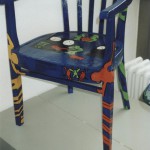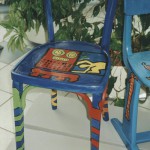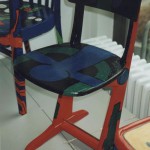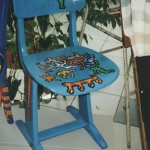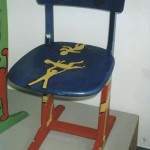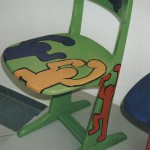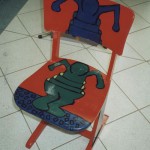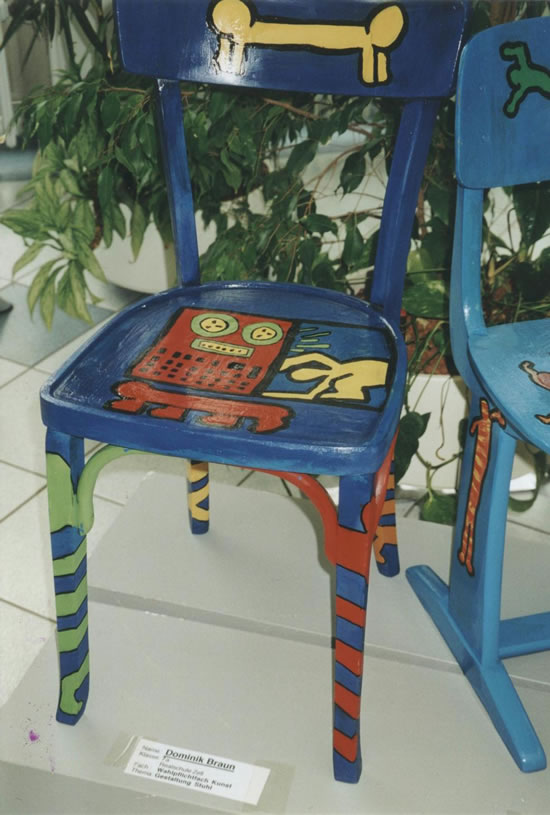
Categories
- Curriculum: Art | Community Service | Language Arts | Social Studies
- Age/Grade: Middle School | Above 14
- Subject: Painting | Analysis and Theory | Sculpture | Exhibition
- Materials: Mixed Media | Paint
- Institution: School of Visual Arts
- Location: New York, New York
- Duration: 3 - 4 Classes
Description
When a college student combines her studies in Art Education with a local high school, a large-scale sculptural work becomes the centerpiece.
Objective
Each student will decorate a chair with his or her own symbols, "tags", and designs. The chair will be personalized and specific to the individual. Then, they will collaborate on painting a table dedicated to a specific issue that the class has chosen. The completed project will appear in the Yeshiva University Museum's sculpture garden/outdoor gallery for the Fall 2001 opening.
By working on large-scale physical objects, the students will learn to enhance every day objects and perceive them as works of art, without altering their original purpose.
Painting directly on three-dimensional objects, preparing and protecting surfaces for utilitarian and outdoor use.
The students will both maintain their individual freedom while working as a group on a collaborative project. The project will emphasize the importance of both. Many chairs and one table can be seen as a metaphor for the individual versus the community. Chairs and tables function on their own, but ultimately, they work better together, and they maintain a higher purpose and significance as a whole.
Resources
See our Katonah Museum Lessons:
Design a Car
Design a Watch
Design a Bicycle
341A | Drawing The Line - A Portrait of Keith Haring | Video | $20.00
-Call Pop Shop, 212.219.2784-
Materials
One chair per student
table
waterproof paint
primer
drop cloth
brushes
water buckets
smocks if necessary
sealer/top coat/gloss
Procedure
Each class will begin with basic concepts and art historical material as background information for the students. They will discuss different art methods and incorporate their ideas with those of past artists, applying them all to their actual work. Each week will progress, building on the last class and adding new concepts for the students to work with. First, they will complete the individual chairs and then work on the table collaboratively.
CLASS 1
Introduction of the project, including the final museum exhibit.
Short video called Drawing The Line (about Keith Haring and his work%29
Discussion about Symbolism, personal and universal.
1. Keith Haring
2. Hieroglyphics
3. Aboriginal Art
4. Graffiti Art (Tags)
5. Ghana symbols
Questions For Discussion
1. What is the difference between a symbol for something and the object itself?
2. Why would you use a symbol?
3. Can you give example of symbols we see everyday? (Universal vs. man-made)
4. Is brail a symbol? Why or why not?
5. Can symbols replace language?
6. If you had to pick a symbol for yourself what would it be?
7. Are there pre-existing symbols that are important to you?
Go over materials and use of materials and prime wood, if necessary.
Begin painting using symbols of yourself or things that are important to you.
CLASS 2 Continue on individual chairs, but this week include text/letters/tags.
Discussion about the nature of the "signature" in our culture.
1. John Hancock
2. Graffiti Artists- Daze & Koor
Discussion about poetry and art, how words and images coexist.
Questions For Discussion
1. Why do we need a signature?
2. What does a signature tell you about a person?
3. Is a signature a drawing?
4. Does text enhance drawing? Why or why not?
5. How do poetry and the visual arts compare?
6. Can letters be seen as lines disassociated from their meanings?
7. Name some elements graffiti artists have used. (Block and bubble letters)
8. How do these elements effect what is written?
9. What makes graffiti art?
10. What is a tag?
Continue painting using new elements discussed in class.
CLASS 3 Continue on individual chairs, but this week including decoration.
Discussion about the need for decoration in our society.
1. Kenny Scharf
2. Keith Haring
3. Vases from Ancient Greece
4. Roy Lichtenstein
5. Robert Rauschenberg
Discussion about how decoration changes an object.
Questions For Discussion
1. Is decoration purely for aesthetic purposes?
2. What is the difference between a bottle that says "Soda" and a bottle that says "Coke"?
3. Do decorations tell us about the function of the object?
4. Can decorations change the function of the object? (Arizona Iced Tea bottles became collectibles because they were painted so nicely).
Go over different types of decoration using examples such as geometric, Celtic boarders, romantic flourishes, ornamental designs, etc
Continue painting individual chairs by adding different types of decoration to the unfilled areas.
Questions
How have we used Keith Haring's ideas and made them our own?
What does it mean to you and how does it make you feel to have your finished work exhibited in a Museum?
What issues do you feel we can address as a class that relates to everyone? Why?
What is the connection between the individual chairs and collaborative table?
Extensions
The author of this lesson, Ahuva Mantell, a student of the School of Visual Arts in NYC, is the 2000-2001 scholarship recipient of the Keith Haring Scholarship award. This project was a collaboration with The School of Visual Arts & Ramaz Upper School.
To find out more about The Keith Haring Foundation Scholarship offered through the School of Visual Arts, please contact:
Director, School of Visual Arts/Visual Arts Foundation, 15 Gramercy Park South, NYC 10003.
SVA's web site
Ramaz's web site
